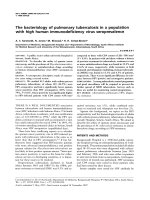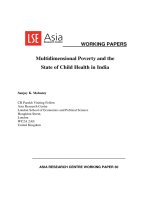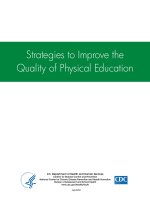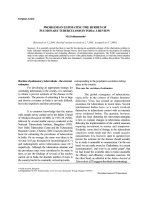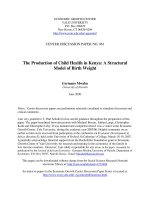WeChat app-based reinforced education improves the quality of opioid titration treatment of cancer-related pain in outpatients: A randomized control study
Bạn đang xem bản rút gọn của tài liệu. Xem và tải ngay bản đầy đủ của tài liệu tại đây (701.55 KB, 8 trang )
Peng et al. BMC Cancer
(2020) 20:852
/>
RESEARCH ARTICLE
Open Access
WeChat app-based reinforced education
improves the quality of opioid titration
treatment of cancer-related pain in
outpatients: a randomized control study
Zhiyou Peng1†, Lin Li2†, Yuan Chen3, Zhiying Feng1* and Xiangming Fang4*
Abstract
Background: As inadequate pain communication contributes to difficulties in optimizing outcomes of outpatients,
we investigated the effect of reinforced education using WeChat App to the opioid titration treatment of cancerrelated pain in the outpatient setting.
Methods: We conducted a prospective study to compare reinforced education using Wechat with care as usual
from February to December 2019. Patients in the reinforced education group received reinforced education via
Wechat, while those in the control group received care as usual. Effect measurements for both groups are carried
out with questionnaires at the baseline and 3 days later. Questionnaires include pain intensity (NRS), treatmentrelated adverse events, cancer-related quality of life (QOL), sleep (PSQI), satisfaction, anxiety (GAD-7) and depression
(PHQ-9). Number of patients whose NRS reduced to less than three points in 24 h was the primary outcomes.
Secondary outcomes included treatment-related adverse events, cancer-related quality of life, sleep, satisfaction,
anxiety and depression.
Results: Although there was no significant difference regarding pain intensity (NRS) between the two groups at 72
h, the rate of NRS that reduced to less than three points in 24 h was significantly higher in the Wechat group than
in the control group. Patients’ satisfaction was significantly higher in the Wechat group than in the control group.
There was no significant difference between the two groups regarding the other findings at 72 h, including pain
intensity (NRS), cancer-related quality of life (QOL), anxiety (GAD-7), depression (PHQ-9), and sleep (PSQI). However,
no significant difference was found between the two groups for constipation, nausea, vomiting, dizziness,
somnolence, pruritus, loss of consciousness, and death.
(Continued on next page)
* Correspondence: ;
†
Zhiyou Peng and Lin Li contributed equally to this work.
1
Department of Pain Medicine, the First Affiliated Hospital, Zhejiang
University School of Medicine, Hangzhou, China
4
Department of Anesthesiology, the First Affiliated Hospital, Zhejiang
University School of Medicine, Hangzhou, China
Full list of author information is available at the end of the article
© The Author(s). 2020 Open Access This article is licensed under a Creative Commons Attribution 4.0 International License,
which permits use, sharing, adaptation, distribution and reproduction in any medium or format, as long as you give
appropriate credit to the original author(s) and the source, provide a link to the Creative Commons licence, and indicate if
changes were made. The images or other third party material in this article are included in the article's Creative Commons
licence, unless indicated otherwise in a credit line to the material. If material is not included in the article's Creative Commons
licence and your intended use is not permitted by statutory regulation or exceeds the permitted use, you will need to obtain
permission directly from the copyright holder. To view a copy of this licence, visit />The Creative Commons Public Domain Dedication waiver ( applies to the
data made available in this article, unless otherwise stated in a credit line to the data.
Peng et al. BMC Cancer
(2020) 20:852
Page 2 of 8
(Continued from previous page)
Conclusions: Our results indicated that receiving instructions delivered by Wechat resulted an increased number of
patients with good pain control and better satisfaction. The study provided insight into the effectiveness of the
reinforced education using a Wechat app delivered by a doctor to outpatients in the titration treatment of cancerrelated pain.
Trial registration: This study was registered at chictr.org (Registration number: ChiCTR1900021150, Date of
Registration: January 30, 2019).
Keywords: WeChat app, Opioid titration treatment, Cancer-related pain, Outpatients
Background
Pain is the most significant concerns of many patients
secondary to their disease and significantly impacting
upon their quality of life. It is a considerable challenge
to management of this pain successfully, especially for
outpatients. Following the World Health Organization
(WHO) analgesic ladder, treatment with strong opioids
can be considered the mainstay of cancer pain therapy
[1, 2]. However, many terminal cancer patients prefer to
be at home than anywhere else. There is an increasing
requirement of family carers’ role in managing cancerrelated pain and providing palliative care at home [3].
However, cancer patients at home are less likely to have
access to adequate analgesia compared to those in hospital [4, 5]. As pain is a subjective experience, patients
who experience pain at home cannot get timely treatment if they cannot recognize and deal with it correctly
or cannot contact the doctor in time.
Adequate knowledge and understanding of pain and
analgesic medications is critical for managing cancer
pain, and influences on the quality of pain management
for patients at home [6]. Distinguishing and handling
risk factors for adverse reactions, the titration of the
dose based on pain level and knowing where to obtain
additional information are the foundation of effective
cancer pain management. Considering these challenges
and the barriers that have been identified in the outpatient setting, patients need to be supported with reinforced education through more comprehensive and
timely help [7, 8]. Thomas ML, et al. promoted education or motivational-interviewing-based coaching compared to usual care to improve cancer pain management
[9]. Improving titration treatment of cancer-related pain
through traditional communication routines, including
face-to-face verbal education, written booklets or visual
aids or telephone-based re-instruction, has proven useful
[10]. However, the effectiveness and applicability of these
interventions have been shown to be inconsistent. So,
newly healthcare technology is promising in facilitating
telemonitoring to enhance education management.
In recent years, Wechat provided an easily accessible
and interactive channel of communication between patients and medical providers, playing an important role
in optimizing clinical work [11, 12]. As a pain monitor
has been identified as an important barrier to adequate
pain management in the outpatient setting, we tested
the hypothesis that reinforced education with Wechat is
promising in terms of enhancing the cancer pain management of outpatients.
Methods
A prospective, randomized, controlled study was conducted at the First Affiliated Hospital, Zhejiang University School of Medicine. The study was approved by the
institutional review board of the first affiliated hospital,
Zhejiang University School of Medicine, and was registered at chictr.org (ChiCTR1900021150). Written informed consent was obtained from all patients and our
study adhered to CONSORT guidelines. According to
the WHO’s three-step principle, individuals over the age
of 18 years of age and not older than 75 years who needs
to start opiate titration in outpatient clinics were enrolled in the study, which took place from February to
December 2019.
Patients meeting the following inclusion criteria were
eligible to participate: subjects voluntarily signed the informed consent for the clinical observation; Subject had
a digital score of persistent pain (≥4) and (or) number of
breakthrough cancer pain (≥3 times per day) originated
from cancer, regardless of distant metastasis; pain is
mainly caused by physical factors, not mental and psychological factors; subjects or caregivers can use Wechat
skillfully. We defined breakthrough cancer pain as “a
transient exacerbation of pain that occurs either spontaneously, or in relation to a specific predictable or
unpredictable trigger, despite relatively stable and adequately controlled background pain” [13]. Patients were
excluded if they met the following exclusion criteria: had
a history of alcohol abuse, drug or opium abuse; new
anti-cancer drugs or new radiotherapy schemes were
used during clinical observation; cognitive deficits or
mental disorders, or consciousness disorders; pregnancy
or lactation; morphine-related contraindications; patients
with unstable vital signs; patients participating in another interventional clinical study.
Peng et al. BMC Cancer
(2020) 20:852
Page 3 of 8
According to the order of the patients enrolled, the patients were assigned to the Wechat group or the control
group according to the computer-generated random
numbers plan.
half of the total amount of morphine immediate-release
tablets and oxycodone sustained-release tablets in the
first 24 h. The rescue dose is 10–20% of the total dose of
drugs in the first 24 h [14, 15].
Protocol of opioid titration treatment
Education
The National Comprehensive Cancer Network’s
(NCCN) clinical practice guidelines in adult cancer pain,
this protocol defines the dose of oral morphine, the
interval, absence of limitation of the total dose, numerical rating scale (NRS) threshold required to administer
morphine, criteria to stop titration, and how to convert
immediate-release morphine into sustained-release
oxycodone. Figure 1 describes the titration schedule.
Morphine titration is administered until a NRS ≤ 3 is
reached, or until the onset of a serious adverse events.
Patients themselves recorded the pain score and adverse
events in their record book. Patients were told to go to
nearby medical institutions to seek help if they experienced adverse events. Patients considered opioid tolerant
were those who had been taking for a week or longer at
least 60 mg of morphine daily, or at least 30 mg of oral
oxycodone daily, or an equianalgesic dose of another
opioid. Pain scores was evaluated every 4 h and morphine immediate-release tablets were given when the
NRS score was greater than 3. The sustained dose was
Any questions were answered at the initial appointment.
Reinforced education was provided by one experienced
doctor through Wechat. Based on the standardized management of cancer pain in the control group, Wechat
was used to provide reinforced education. Wechat Subscription Platform was used to publish information including the pain score, knowledge related to opioid
analgesics, role of such drugs, common errors when taking tablets, possible adverse reactions, and prevention
and treatment methods. Doctors actively and timeously
answered patients’ concerns regarding the treatment,
and marked the department contact telephone on the
subscription plat information column. Members of the
pain control group used Wechat to communicate using
either voice or text depending on the patient’s needs in
the micro-letter. We tried to enable all participants to
achieve satisfactory pain control and handle risk factors
related to opioid use.
Other than answering questions at the initial appointment, patients in the control group received no further
Fig. 1 The schedule of opioid titration treatment
Peng et al. BMC Cancer
(2020) 20:852
active education from doctors. Afterward, patients were
seen again at the outpatient clinic for further education
or contacted by phone for a follow-up consultation. The
timing and frequency of the follow-up consultation differed according to patients’ general conditions.
Patients in the reinforced education group received reinforced education via Wechat, while those in the control group received care as usual. Wechat Subscription
Plat is used to publish information, which includes pain
score and opioid analgesics related knowledge. Doctors
actively answered patients’ doubts in the treatment in
time. We strived to let all participants be able to achieve
satisfactory pain control and how to handle risk factors
related to opioid using. The intervention period and the
control period before study assessments were conducted
was 72 h the initial appointment.
Outcome assessments
Number of patients whose NRS reduced to less than
three points in 24 h was the primary outcomes. Secondary outcomes included pain intensity (NRS), satisfaction
with pain management and pain intensity, sleep (Pittsburgh sleep quality index, PSQI), anxiety (Generalized
anxiety disorder-7, GAD-7), depression (Patient health
questionnaire-9, PHQ-9), and cancer-related quality of
life (QOL) at 72 h after the initionation of treatment. In
addition, treatment-related adverse events including
nausea, vomiting, dizziness, somnolence, pruritus, loss of
consciousness and death were also recorded.
GAD-7 and PHQ-9
We used the GAD-7 and PHQ-9 to measure the anxiety and depression. The reliability and validity of
GAD-7 and PHQ-9 are well established and they are
commonly used as self-report tools to evaluate the severity of anxiety and depression. Patients whose
scores are greater than 4 on the GAD-7 or the PHQ9 are considered as suffering from anxiety or depression, respectively [16, 17].
PSQI
The PSQI was used to evaluate patients’ sleep quality of
patients. This scale consists of 18 self-report items that
are divided into 7 dimensions, namely subjective sleep
quality, time to fall asleep, sleep duration, sleep efficiency, sleep disturbances, use of sleep medication, and
daytime dysfunction. The score on each dimension
ranges from 0 to 3 and higher total scores indicate lower
sleep quality [18].
Page 4 of 8
family coordination, colleagues coordination, oneself understanding of cancer, attitude to treatment, daily life,
side effects of treatment, facial expressions. The score
on each dimension ranges from 1 to 5 with the total
scores as 60 and higher total scores indicate better quality of life.
Statistical analysis
Patients in the Wechat and control groups were expected to show a 15% improvement (from 75 to 90%) in
the rate of NRS ≤ 3 within 24 h. Thus, a sample size of
130 patients in each group was required for a statistical
power of 80% at a two-tailed significance level of 0.05.
Assuming a 10% dropout rate, it was deemed that 145
patients per group would be required to obtain statistically significant results for the primary outcome.
Continuous variables were presented as means ±
standard deviation, and categorical data were shown as
numbers and percentages. For different variable types,
we employ different approaches to evaluate their differences. For categorical variables, we employ Chi-squared
tests to evaluate the variable differences. While for continuous variables, we adopt Student’s T test to assess
their differences. The statistical significance is measured
by p value, and p < 0.05 indicated statistical significance.
All analyses were performed using the SPSS software
(Ver. 24.0; IBM Corp., New York, USA).
Result
Between February and December 2019, 380 outpatients
were considered for the purposes of this study. Figure 2
illustrated the patient recruitment flowchart. The baseline characteristics of two groups were similar, including
the age, gender, level of education, pain site, and message receiver (refer to Table 1).
Although there was no significant difference regarding
pain intensity (NRS) between the two groups at 72 h, the
rate of NRS that reduced to less than three points in 24
h was significantly higher in the Wechat group than in
the control group. Patients’ satisfaction was significantly
higher in the Wechat group than in the control group.
There was no significant difference between the two
groups regarding the other findings at 72 h, including
cancer-related quality of life (QOL), anxiety (GAD-7),
depression (PHQ-9), and sleep (PSQI) (all p > 0.05) (refer
to Table 2).
However, no significant difference was found between
the two groups for constipation, nausea, vomiting, dizziness, somnolence, pruritus, loss of consciousness, and
death (refer to Table 3).
QOL
The QOL was used for evaluating the quality of life of
cancer patients. This scale consists of 12 self-report
items, including appetite, spirit, sleep, fatigue, pain,
Discussions
The study provides insight into the effectiveness of education reinforced with Wechat delivered by a doctor to
Peng et al. BMC Cancer
(2020) 20:852
Page 5 of 8
Fig. 2 Patients recruitment flowchart
outpatients on the titration treatment of cancer-related
pain. Our results indicated that patients receiving instructions delivered by Wechat had a relatively higher
quality of opioid titration treatment and better
satisfaction.
As actual cancer pain management in outpatient
settings have different kinds of problems in practice,
clinicians urgently need of a promising solution for
follow-ups with outpatients to strengthen pain medication management [19, 20]. Although information on the
use of opioids for improving the opioid titration treatment of cancer-related pain can be easily found on the
internet, it’s not easy for patients to get what they really
need. After evaluated a technology-based multicomponent self-management support intervention that
combines the monitoring of pain, adverse effects, and
medication with graphical feedback, education, and
nurse support, it was found that self-management support results in better pain control and better quality of
life than care as usual [21]. The results of a systematic
review of intervention studies suggests that educational
interventions delivered face-to-face, supported by written and/or other resources, and by appropriate followups can potentially improve family carers’ knowledge
and self-efficacy for pain management and reduce attitudinal barriers [8]. To the bet of our knowledge, this is
the first study demonstrating that Wechat, as an adjunct
to regular instructions, improves the opioid titration
treatment of cancer-related pain in outpatients. This
may be because Wechat allowed patients with more
Table 1 Baseline characteristics of the study patients
Wechat group (n = 152)
Control group (n = 150)
Age (years), mean (SD)
55.6 ± 6.8
56.3 ± 7.0
Female (n)
80 (52.6%)
78 (52.0%)
Smoke history (n)
27 (17.8%)
24 (16.0%)
Hypertension (n)
33 (21.7%)
28 (18.7%)
Diabetes (n)
Level of education (n)
Pain site (n)
Message receiver
12 (7.9%)
14 (9.3%)
Elementary school or less
20 (13.2%)
22 (14.7%)
High school
92 (60.5%)
90 (60.0%)
College or higher
40 (26.3%)
38 (25.3%)
Abdomen
92 (60.5%)
93 (62.0%)
Chest
38 (25%)
36 (24.0%)
Limb
12 (7.9%)
14 (9.3%)
Head
10 (6.6%)
7 (4.7%)
Patients
32 (21.1%)
33 (22.0%)
Caregivers
120 (78.9%)
117 (78.0%)
Peng et al. BMC Cancer
(2020) 20:852
Page 6 of 8
Table 2 Effect of reinforced education with Wechat on the outcome of cancer pain management at 72 h. T0: baseline, T1:72 h after
treatment, *p < 0.05
Outcome measures
Wechat group (n = 152)
Group Control (n = 150)
T0
T1
T0
T1
Pain intensity (NRS)
6.8 ± 1.9
2.5 ± 1.2
6.6 ± 2.1
2.8 ± 1.1
Cancer-related quality of life (QOL)
35.2 ± 6.5
46.3 ± 5.5
36.3 ± 6.2
43.4 ± 5.2
Anxiety (GAD-7)
16.1 ± 3.3
9.8 ± 2.2
16.3 ± 3.6
12.4 ± 3.1
Depression (PHQ-9)
17.2 ± 3.0
10.1 ± 2.8
16.7 ± 3.4
11.2 ± 2.2
Sleep (PSQI)
17.2 ± 4.2
12.7 ± 3.3
18.4 ± 4.6
14.6 ± 3.9
NRS that reduced to less than 3 (n)
146 (96.1%)
122(81.3%)*
Satisfied patients (n)
130 (85.5%)
112(74.7%)*
NRS numerical rating scale; QOL cancer-related quality of life; GAD-7 Generalized anxiety disorder-7; PHQ-9 Patient health questionnaire-9; PSQI Pittsburgh sleep
quality index. Continuous variables were presented as means ± SD, and categorical data were shown as numbers and percentages
access to knowledge related to treatment, ensured that
patients knew how to seek help, and ensured that they
received a timely response when suffering severe pain or
adverse drug reactions.
Our results indicated no significant difference regarding pain intensity (NRS) between the two groups at 72 h;
however, the rate of NRS that reduced to less than 3
points in 24 h was significantly higher in the Wechat
group than in the control group. Patients’ satisfaction
with pain management and pain intensity was significantly higher in the Wechat group than in the control
group. There were no significant differences between the
two groups regarding the other findings at 72 h, including cancer related quality of life (QOL), anxiety (GAD7), depression (PHQ-9) and sleep (PSQI).
The frequent occurrence of unwanted side effects may
be a barrier to optimal dosing and patients’ compliance,
especially for patients at home. It has been suggested
that the goal of the opioid titration treatment of cancerrelated pain in outpatients is to find a favorable balance
between pain control and side effects [22, 23]. However,
no significant scores were found for two groups for
constipation, nausea, vomiting, dizziness, somnolence,
pruritus, loss of consciousness, and death. The majority
of the adverse effects were mild to moderate in severity,
Table 3 Treatment-related adverse events reported during the
procedure. *p < 0.05
Outcome measures
Wechat group (n = 152) Control group (n = 150)
Constipation
20 (13.2%)
22 (14.5%)
Nausea
10 (6.6%)
12 (8.0%)
Vomiting
7 (4.6%)
9 (6.0%)
Dizziness
5 (3.3%)
8 (5.3%)
Somnolence
0
1 (0.7%)
Pruritus
1 (0.7%)
0
Loss of consciousness 0
0
Death
0
0
with similar profiles for the two groups. This may be
mainly because our research mainly focuses on the incidence of adverse events, while the treatment of these
adverse reactions needs a certain period of time. In the
future, we need to pay attention to the effect of wechat
education on the treatment of adverse reactions. Taken
together, these results suggest the beneficial effect of reinforced education using Wechat in the management of
the opioid titration treatment of cancer-related pain in
outpatients.
Compared to care as usual, reinforced education using
Wechat result in better pain control and better patients’
satisfaction, contributing to improve cancer pain in outpatients. The intervention could be used for other
cancer-related health problems or pain problems in
other chronic disease populations [8, 21, 24]. Patients require assistance to easily access information on pain and
pain medication, and on when and how to get help [25,
26]. Patients also need to be able to recognize and monitor pain and adverse events to gain insight into their
own situation and feedback about how they are doing.
In the current period of virus epidemic, Wechat may
also optimize the pain management and prevents crossinfections among medical workers and patients, which
may help to alleviate shortages in the medical workforce
to fight COVID-19 on the front line [27].
This study has some limitations. As this study mainly
evaluated the effect of Wechat-based reinforced education on opioid titration, the follow-up time was only 3
days. In the future, evaluating the long-term help of
Wechat for cancer pain management should be considered. In addition, although we try to obtain patient’s information through data acquisition and analysis in order
to obtain better clinical protocols, it is impossible to do
big data analysis due to the limitation of the number of
patients. However, this may be a good research direction
in the future. Better programs should be developed to
apply to a larger number of people, so as to do big data
analysis and artificial intelligence analysis to obtain the
Peng et al. BMC Cancer
(2020) 20:852
optimal diagnosis and treatment automatically in the future, which will better serve for public health.
Conclusions
Our results indicated that patients receiving instructions
delivered by Wechat had a relatively higher quality of
opioid titration treatment and better satisfaction. To
provide long-term support for a wider population of
cancer patients with pain, clinicians should integrate
evidence-based activities to support reinforced education
in routine clinical practice.
Abbreviations
NRS: Numerical rating scale; QOL: Cancer-related quality of life; GAD7: Generalized anxiety disorder-7; PHQ-9: Patient health questionnaire-9;
PSQI: Pittsburgh sleep quality index; WHO: World Health Organization;
NCCN: National Comprehensive Cancer Network
Acknowledgements
We thanks to the editorial department of Journal of Zhejiang University for
polishing this article.
Authors’ contributions
ZYP and XMF conceived and designed the study. ZYP, LL and YC performed
the study. ZYP and ZYF analyzed the data. ZYP wrote the paper and ZYF
critically reviewed the manuscript. All authors have read and approved the
manuscript.
Funding
This research was supported by Zhejiang health and Family Planning
Commission (Grant no. 2019RC173) to Dr. Zhiyou Peng and Hangzhou
Science and Technology Commission (20180533B36) to Yuan Chen. These
are earmarked funds for cancer research. The funding bodies have no role in
study design, data collection, data analysis, data interpretation, or manuscript
preparation.
Page 7 of 8
2.
3.
4.
5.
6.
7.
8.
9.
10.
11.
12.
Availability of data and materials
The data used to support the findings of this study are available from the
corresponding author upon request.
13.
Ethics approval and consent to participate
The study was approved by the institutional review board of the first
affiliated hospital, Zhejiang University School of Medicine, and was registered
at chictr.org (ChiCTR1900021150). The written consent statement were
obtained from all individual participants. Informed consent was obtained
from all individual participants included in the study.
14.
Consent for publication
Not applicable.
Competing interests
The authors declare that they have no competing of interests.
Author details
1
Department of Pain Medicine, the First Affiliated Hospital, Zhejiang
University School of Medicine, Hangzhou, China. 2Department of
Anesthesiology, Yuyao people’s Hospital, Ningbo, China. 3Department of
Anesthesiology, Hangzhou first people’s Hospital, Hangzhou, China.
4
Department of Anesthesiology, the First Affiliated Hospital, Zhejiang
University School of Medicine, Hangzhou, China.
15.
16.
17.
18.
19.
20.
Received: 31 March 2020 Accepted: 7 August 2020
21.
References
1. Schumacher KL, Plano Clark VL, West CM, Dodd MJ, Rabow MW, Miaskowski
C. Pain medication management processes used by oncology outpatients
and family caregivers part II home and lifestyle contexts. J Pain Symptom
Manag. 2014;48:784–96.
Ebenau A, Dijkstra B, Ter Huurne C, Hasselaar J, Vissers K, Groot M. Palliative
care for people with substance use disorder and multiple problems: a
qualitative study on experiences of patients and proxies. BMC Palliat Care.
2019;18(1):56.
Payne S, Turner M, Seamark D, Thomas C, Brearley S, Wang X, Blake S,
Milligan C. Managing end of life medications at home-accounts of bereaved
family carers: a qualitative interview study. BMJ Support Palliat Care. 2015;5:
181–8.
ElMokhallalati Y, Mulvey MR, Bennett MI. Interventions to support selfmanagement in cancer pain. Pain Rep. 2018;3:e690.
Schulman-Green D, Feder S. Integrating family caregivers into palliative
oncology care using the self- and family management approach. Semin
Oncol Nurs. 2018;34(3):252–63.
van Ryn M, Sanders S, Kahn K, van Houtven C, Griffin JM, Martin M, Atienza
AA, Phelan S, Finstad D, Rowland J. Objective burden, resources, and other
stressors among informal cancer caregivers: a hidden quality issue?
Psychooncology. 2011;20:44–52.
McCorkle R, Ercolano E, Lazenby M, Schulman-Green D, Schilling LS, Lorig K,
Wagner EH. Self-management: enabling and empowering patients living
with cancer as a chronic illness. CA Cancer J Clin. 2011;61(1):50–62.
Latter S, Hopkinson JB, Richardson A, Hughes JA, Lowson E, Edwards D.
How can we help family carers manage pain medicines for patients with
advanced cancer? A systematic review of intervention studies. BMJ Support
Palliat Care. 2016;6(3):263–75.
Thomas ML, Elliott JE, Rao SM, Fahey KF, Paul SM, Miaskowski C. A
randomized, clinical trial of education or motivational-interviewing-based
coaching compared to usual care to improve cancer pain management.
Oncol Nurs Forum. 2012;39:39–49.
Oldenmenger WH, Sillevis Smitt PA, van Dooren S, Stoter G, van der Rijt CC.
A systematic review on barriers hindering adequate cancer pain
management and interventions to reduce them: a critical appraisal. Eur J
Cancer. 2009;45(8):1370–80.
St Louis C, Zorlu G. Can twitter predict disease outbreaks? BMJ. 2012;344:
e2353.
Davies AN, Dickman A, Reid C, et al. The management of cancer-related
breakthrough pain: recommendations of a task group of the Science
Committee of the Association for Palliative Medicine of Great Britain and
Ireland. Eur J Pain. 2009;13:331–8.
Kang X, Zhao L, Leung F, Luo H, Wang L, Wu J, Guo X, Wang X, Zhang L,
Hui N, Tao Q, Jia H, Liu Z, Chen Z, Liu J, Wu K, Fan D, Pan Y, Guo X. Delivery
of instructions via Mobile Social media app increases quality of bowel
preparation. Clin Gastroenterol Hepatol. 2016;14(429–35):e3.
Lester P, Remolana R, Sandhu S, Scott J. Road map for opioid Management
in the Inpatient Setting: a structured approach to opioid selection and
titration. MedEdPORTAL. 2016;12:10470.
Pan H, Shen P, Shu Q, Lu L, Qian S, Zhou Y, Han F, Guo Q, Yang Z, Pan J, Xu
Q, Zhang P, Wang K. Efficacy and safety of sustained-release oxycodone
compared with immediate-release morphine for pain titration in cancer
patients: a multicenter, open-label, randomized controlled trial (SOCIAL).
Medicine (Baltimore). 2019;98:e15505.
Parkerson HA, Thibodeau MA, Brandt CP, Zvolensky MJ, Asmundson GJ.
Cultural-based biases of the GAD-7. J Anxiety Disord. 2015;31:38–42.
Hyphantis T, Kotsis K, Kroenke K, Paika V, Constantopoulos S, Drosos AA,
Carvalho AF, Guthrie E. Lower PHQ-9 cut-point accurately diagnosed
depression in people with long-term conditions attending the accident and
emergency department. J Affect Disord. 2015;176:155–63.
Jiang Y, Tang Y-R, Xie C, Yu T, Xiong W-J, Lin L. Influence of sleep disorders
on somatic symptoms, mental health, and quality of life in patients with
chronic constipation. Medicine (Baltimore). 2017;96(7):e6093.
Bee P, Barnes P, Luker K. A systematic review of informal caregivers’ needs
in providing home-based end-of-life care to people with cancer. J Clin Nurs.
2008;18:1379–93.21.
Koller A, Miaskowski C, De Geest S, Opitz O, Spichiger E. Supporting selfmanagement of pain in cancer patients: methods and lessons learned from
a randomized controlled pilot study. Eur J Oncol Nurs. 2013;17:1–8.
Hochstenbach LM, Courtens AM, Zwakhalen SM, van Kleef M, de Witte LP.
Self-management support intervention to control cancer pain in the
outpatient setting: a randomized controlled trial study protocol. BMC
Cancer. 2015;15:416.
Peng et al. BMC Cancer
(2020) 20:852
22. Hartung DM, Middleton L, Haxby DG, Koder M, Ketchum KL, Chou R. Rates
of adverse events of long-acting opioids in a state Medicaid program. Ann
Pharmacother. 2007;41:921–8.
23. Webster L. Efficacy and safety of dual-opioid therapy in acute pain. Pain
Med. 2012;13(suppl 1):S12–20.
24. Valenta S, Spirig R, Miaskowski C, Zaugg K, Spichiger E. Testing a pain selfmanagement intervention by exploring reduction of analgesics' side effects
in cancer outpatients and the involvement of family caregivers: a study
protocol (PEINCA-FAM). BMC Nurs. 2018;17:54.
25. Lee YJ, Kim ES, Choi JH, Lee KI, Park KS, Cho KB, Jang BK, Chung WJ, Hwang
JS. Impact of reinforced education by telephone and short message service
on the quality of bowel preparation: a randomized controlled study.
Endoscopy. 2015;47:1018–27.
26. Liu X, Luo H, Zhang L, Leung FW, Liu Z, Wang X, Huang R, Hui N, Wu K, Fan
D, Pan Y, Guo X. Telephone-based re-education on the day before
colonoscopy improves the quality of bowel preparation and the polyp
detection rate: a prospective, colonoscopist-blinded, randomised, controlled
study. Gut. 2014;63:125–30.
27. Xu H, Huang S, Qiu C, Liu S, Deng J, Jiao B, Tan X, Ai L, Xiao Y, Belliato M,
Yan L. Monitoring and Management of Home-Quarantined Patients with
COVID-19 using a WeChat-based telemedicine system: retrospective cohort
study. J Med Internet Res. 2020;22(7):e19514.
Publisher’s Note
Springer Nature remains neutral with regard to jurisdictional claims in
published maps and institutional affiliations.
Page 8 of 8


